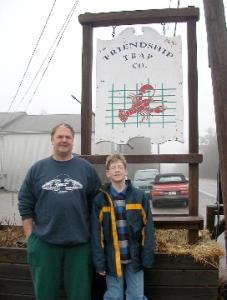Pike Bartlett

Finding Friendship Oral History Project
The Finding Friendship Oral History Project is a joint effort of the Friendship Museum and the Friendship Village School, directed by Sally Merrick, museum volunteer, and Gaylea Hynd, teacher. In 2003-2004 sixth grade students conducted taped interviews of three generations of lobstermen and women, as well as others associated with the lobstering industry. Printed copies of the interviews and CDs of the printed transcripts are available at the Friendship Museum in Friendship, Maine.
Sally Merrick
Pike Bartlett, born on February 3, 1951, is a prominent figure in the lobster trap industry. Originally from Massachusetts, he relocated to Friendship, Maine, in 1973. His personal interests revolve around outdoor activities such as skiing, sailing, and motorcycling. As the president and owner of the Friendship Trap Company, Bartlett has played a pivotal role in the company's success since its establishment in 1977. The company specializes in the production of lobster traps, utilizing rolls of wire and bales of mesh to craft durable and efficient traps for fishermen.
Scope and Content Note
In this interview, Pike Bartlett discusses his work and experience with the Friendship Trap Company, which he started in 1977. He talks about the advantages of wire over wooden traps, recent innovations in trap making, trap limits, and the future of the industry. Bartlett owns and operates the Friendship Trap Company, which manufactures lobster traps. Bartlett discusses the origins of his business, mentioning that he started the Friendship Trap Company in 1977. Initially, he operated in Massachusetts for a year before establishing a Friendship, Maine building in 1978. Bartlett conducted market research and discovered the numerous advantages of wire traps over wooden traps. They were heavier underwater, providing stability, and lighter on boats, requiring less maintenance. Additionally, wire traps had a higher lobster-catching efficiency due to reduced movement on the ocean floor. Regarding the changes in traps, since he began, Bartlett mentioned the noticeable shift in trap colors. Initially, there was only green wire available, but over time, colors like black, white, gray, yellow, and blue were introduced. Another significant change involved replacing hand-knit trap heads with shrimp lines, a netting material made overseas. Bartlett also highlights the upcoming major change in traps, where concrete runners are replacing wooden runners and bricks. Bartlett acknowledges the challenges in the lobster trap business. As the industry matured, competition increased, making it more price-sensitive. Additionally, government regulations limiting the number of new traps impacted the industry's size. Bartlett discusses the kinds of traps his company produces, the number of traps lobstermen typically have, and the future of the business. He acknowledges the need for caution due to natural predation, such as striped bass and codfish consuming small lobsters. Balancing the ecological impact and ensuring the sustainability of lobster populations remains a priority.
Please Note: The oral histories in this collection are protected by copyright and have been created for educational, research and personal use as described by the Fair Use Doctrine in the U.S. Copyright law. Please reach out Voices@noaa.gov to let us know how these interviews are being used in your research, project, exhibit, etc. The Voices staff can help provide other useful resources related to your inquiry.
The NOAA mission is to understand and predict changes in climate, weather, oceans, and coasts, to share that knowledge and information with others, and to conserve and manage coastal and marine ecosystems and resources. The Voices Oral History Archives offers public access to a wide range of accounts, including historical materials that are products of their particular times, and may contain offensive language or negative stereotypes.
Voices Oral History Archives does not verify the accuracy of materials submitted to us. The opinions expressed in the interviews are those of the interviewee only. The interviews here have been made available to the public only after the interviewer has confirmed that they have obtained consent.
